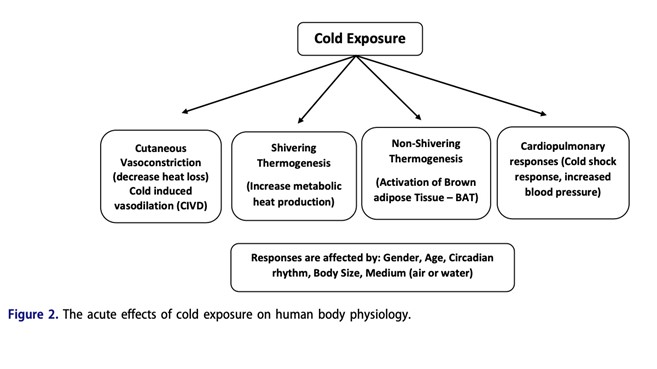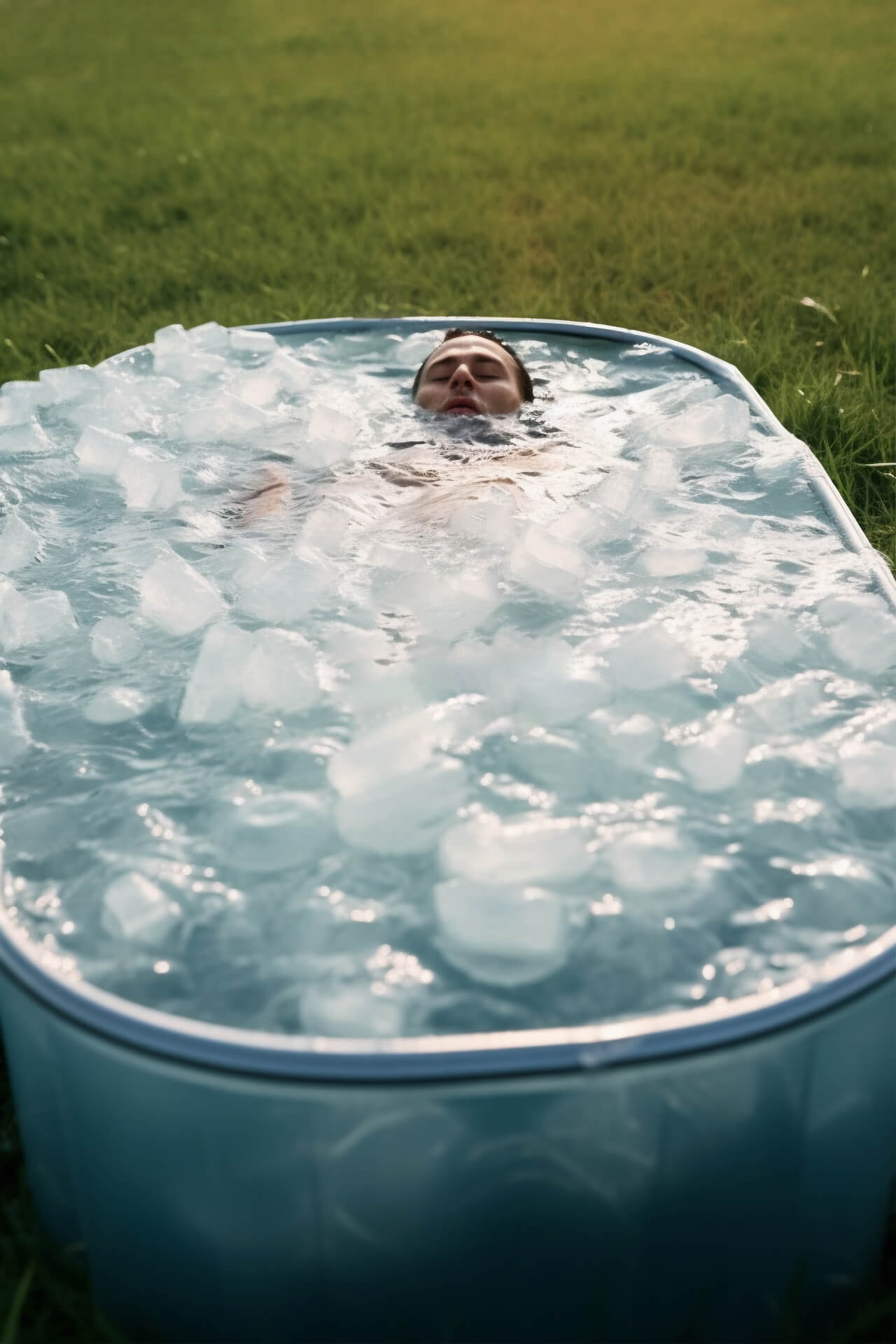
Unlocking the Potential: The Science behind Cold Exposure
C old exposure is anything but a new health and wellness trend. Throughout history, different cultures and societies have harnessed the power of cold for various purposes, ranging from therapeutic benefits to spiritual rituals and endurance feats.
The conscious use of cold, which includes practises such as cold showers, ice baths, and swimming in cold water, has recently become a topic of growing scientific interest due to its diverse physiological and psychological effects.
One of the best-known pioneers of the cold water method is the Dutch extreme athlete Wim Hof: also known as the “Iceman”,” Wim Hof has gained international attention for his ability to withstand extreme temperatures and his advocacy of the health benefits of the method. The method centres on traditional Tibetan and yogic breathing exercises, adapted by Wim Hof, and involves rhythmic cycles of deep inhalations and exhalations followed by breath holding. The controlled breathing is intended to activate the sympathetic nervous system, increase adrenaline levels, and induce a state of heightened concentration and arousal.
In addition to the breathing techniques, the Wim Hof method includes exposure to cold as a core component.
Practitioners gradually expose themselves to cold stimuli such as cold showers, ice baths, or outdoor cold baths to improve circulation, boost immune function, and increase stress resistance. It is recommended to start with shorter cold exposures and gradually increase the duration and intensity, depending on individual tolerance and well-being.
Another focus is on mindset training, emphasising the importance of a positive attitude and mental strength.
Although scientific research demonstrates some physiological changes associated with cold exposure and controlled breathing, further studies are needed to fully understand this method’s mechanisms and long-term effects.
In one of the most comprehensive meta-reviews of studies addressing voluntary exposure to cold water (Espelanda et al., 2022), the data and conclusions of 104 publications were analysed.
These studies showed significant effects on physiological and biochemical parameters, including reductions in body adipose tissue, insulin resistance, and improvements in insulin sensitivity.
While some studies focused on winter swimmers, many enrolled individuals with no prior cold water swimming experience and examined effects such as post-workout treatment. However, limitations such as small sample sizes, gender differences, and differences in water temperature and salt composition prevented firm conclusions.
Exposure to cold water appears to be potentially health-promoting and protective against cardiovascular, obesity, and metabolic diseases; regular exercise could help in the treatment of chronic autoimmune inflammation, reduce hypercholesterolaemia by activating brown adipose tissue and positively influence stress regulation, although the role of lifestyle factors must be considered.

Health effects of voluntary exposure to cold water – a continuing subject of debate Didrik Espelanda , Louis de Weerdb,c and James B. Mercer
INTERNATIONAL JOURNAL OF CIRCUMPOLAR HEALTH 2022, VOL. 81, 2111789 https://doi.org/10.1080/22423982.2022.2111789
The scientific basis of cold exposure lies in the concept of hormesis. Hormesis is a biological principle whereby exposure to mild stressors can trigger positive adaptive responses in the body. Exposure to cold is seen as a hormetic stressor that can lead to various physiological and psychological improvements.

Metabolic benefits
Physiological responses to exposure to cold water challenge the body’s organ systems and require adaptations to maintain core temperature. Mechanisms related to thermoregulation play a critical role in adapting to a cold environment.
- Brown adipose tissue, or brown fat, is a type of fat that burns energy to generate heat (thermogenesis without shivering). Exposure to cold can activate brown fat, which can boost metabolism and support weight management.
- The increased production of adiponectin associated with BAT may offer protection against insulin resistance and age-related diseases.
- The medium to long-term increase in non-fasting thermogenesis and the effect on the insulin and leptin pathways have a positive effect on weight management.
Cardiovascular benefits
- Exposure to cold improves blood flow and tissue oxygenation through vasoconstriction followed by vasodilation.
- Regular exposure to cold can increase cardiac output, stroke volume and heart rate variability, improving cardiovascular efficiency and resilience.
- Reduced inflammation: Exposure to cold has anti-inflammatory effects and can reduce the risk of inflammation-related cardiovascular disease.
- Reduced blood pressure: Despite a temporary increase during exposure, regular exposure to cold can lead to a long-term reduction in blood pressure at rest.
- Improved endothelial function: Exposure to cold promotes the production of nitric oxide, which improves endothelial function and vascular health.
- Positive autonomic modulation: Cold exposure can promote autonomic balance by increasing parasympathetic activity and heart rate variability, improving cardiovascular function and stress resilience.
Hormonal regulation
Conscious exposure to cold triggers a complex hormonal response that includes activation of the sympathetic nervous system, modulation of the HPA axis, regulation of thyroid hormones and, as mentioned above, activation of brown adipose tissue and possible effects on appetite-regulating hormones.
- Catecholamine release: Exposure to cold activates the sympathetic nervous system and releases catecholamines such as epinephrine (adrenaline) and norepinephrine (noradrenaline). These hormones are crucial for increasing the metabolic rate, mobilizing energy substrates (e.g. glucose and fatty acids), and promoting thermogenesis to maintain body temperature in cold environments.
- Activation of the hypothalamic-pituitary-adrenal (HPA) axis: Exposure to cold can stimulate the hypothalamic-pituitary-adrenal (HPA) axis and release the stress hormone cortisol. Cortisol mobilises energy reserves, suppresses inflammation, and helps the body to cope with stress factors. However, chronic or excessive cortisol release due to prolonged exposure to cold can have a detrimental effect on metabolic health and immune function.
- Regulation of thyroid hormones: Exposure to cold can affect thyroid hormone secretion and metabolism. Thyroid hormones such as thyroxine (T4) and triiodothyronine (T3) play a crucial role in regulating metabolic rate, thermogenesis, and energy balance. Exposure to cold can stimulate the release of thyroid hormones, leading to increased metabolic activity and heat production to counteract cold stress.
Recovery
Incorporating cold exposure into a comprehensive recovery strategy can help individuals optimise their recovery and performance, especially athletes and people who engage in intense physical activity.
- Relieving inflammation and muscle soreness: Cold exposure reduces inflammation and muscle soreness after exercise by constricting blood vessels, restricting blood flow to muscles, and reducing the inflammatory response.
- Mitigating muscle damage: Cold exposure minimises exercise-induced muscle damage by reducing oxidative stress and inflammation, preserving muscle integrity and function.
- Facilitate muscle recovery: Cold exposure stimulates the release of growth factors such as insulin-like growth factor 1 (IGF-1) and vascular endothelial growth factor (VEGF), which promote muscle repair, regeneration, and angiogenesis, thus accelerating recovery processes.
- Improving joint flexibility: Cold therapy relieves joint discomfort and stiffness by numbing pain receptors, reducing swelling, and improving blood circulation, resulting in improved joint mobility and flexibility.
- Acceleration of recovery phases: Cold exposure between workouts accelerates recovery by alleviating muscle fatigue, soreness, and inflammation, allowing for more frequent and intense workouts without sacrificing performance.
- Increasing psychological resilience: Exposure to cold promotes psychological resilience by inducing stress-reducing effects, improving mood, and strengthening psychological coping mechanisms, thus contributing to overall well-being and optimising recovery.
Please note that immediate exposure to cold after a workout aimed at hypertrophy hinders its benefits.

Benefits for the immune system:
- Exposure to cold has been shown to stimulate the production of white blood cells, particularly lymphocytes, which play a crucial role in the body’s immune response, potentially improving the body’s ability to fight infection and disease.
- A short daily exposure to cold has been shown to boost the production and activation of natural killer (NK) cells, which are an essential component of cancer immunity.
- This treatment has also been found to increase the number of cytotoxic T cells, which play a crucial role in adaptive immunity.
Mood and neuronal benefits
Exposure to cold is associated with various mood-enhancing effects that can have a positive impact on mental well-being.
- Elevated levels of noradrenaline lead to increased arousal, alertness, and energy as part of the fight-or-flight response; higher levels of noradrenaline are often associated with better mood and improved cognitive function.
- Serotonin levels and activity in the brain are also increased by exposure to cold, either through increased production of this neuromodulator or increased sensitivity of specialised receptors. Serotonin plays a crucial role in the regulation of mood, sleep, appetite, and stress response.
- Dopamine, which is involved in the regulation of motivation and mood, is also released during and after conscious exposure to cold and may contribute to the frequently reported mild euphoric sensations. Dopamine modulates motor and cognitive performance and increases attention and concentration. This neuromodulator also mediates the reinforcing effects of cold exposure practices by promoting persistence and enjoyment of the experience.
Given the growing interest in cold exposure practices and their potential applications, it is crucial for future research to further explore the underlying mechanisms, refine the methods, and evaluate the safety and efficacy of cold exposure interventions in different populations.
Jessica Giuffrida
I’m Jessica Giuffrida, an avid reader and knowledge enthusiast who is always seeking new insights and perspectives. Welcome to my blog!



